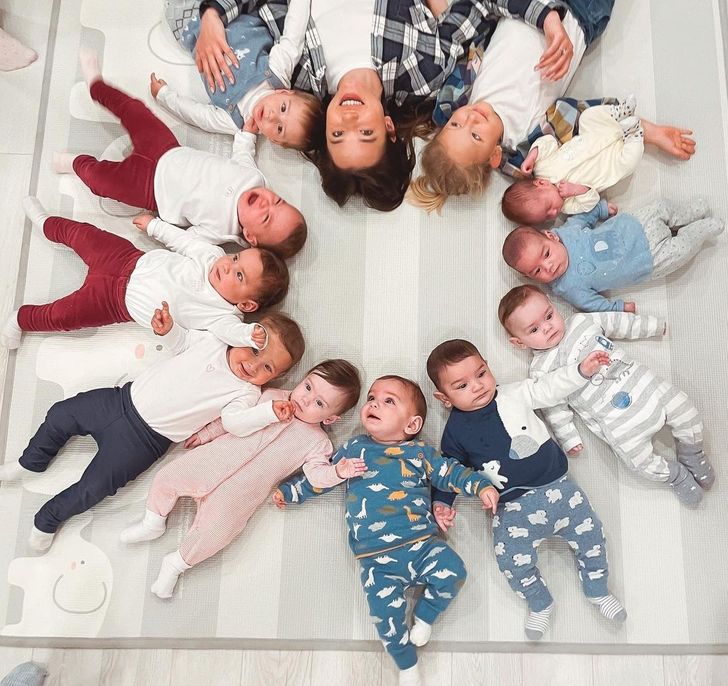Viral content on social media platforms often spreads rapidly, especially when it involves shocking or extraordinary stories. A recent claim suggests that a 23-year-old woman gave birth to 14 babies in a single delivery, which has sparked widespread curiosity and disbelief.
However, there is no credible medical or news report confirming such an event. The claim lacks verification from official medical institutions, hospital records, or reputable media sources.
According to fact-checks conducted by platforms such as Snopes and AFP Fact Check, there is no evidence that this event occurred. The story appears to be a fabrication or exaggeration designed to generate clicks and shares.
Understanding High-Order Multiple Births: What Science Says
Multiple births — such as twins, triplets, or quadruplets — occur when a woman carries more than one fetus during a single pregnancy. Births involving seven or more fetuses, known as high-order multiple births, are extremely rare and medically complex.
The Guinness World Records confirms that the highest number of babies born in a single delivery to survive infancy is eight, a case known as the Suleman Octuplets.
In 2009, Nadya Suleman, an American woman, gave birth to octuplets (eight babies) in California. All eight children survived and were later nicknamed “Octomom” by the media. The delivery, conducted via cesarean section, was the result of in vitro fertilization (IVF), and the case became globally renowned due to its rarity and ethical implications. (Source: Guinness World Records, CNN).
Medical professionals, including those at the National Institutes of Health (NIH), emphasize that pregnancies involving more than four fetuses carry serious health risks, including premature birth, low birth weight, and complications for the mother such as hemorrhaging and preeclampsia.

Historical Context: Notable Cases of High Fertility
While a single delivery involving 14 babies is medically implausible, there are real-life cases of women who have had a large number of children over the course of many years.
1. Mariam Nabatanzi (Uganda)
One widely reported case involves Mariam Nabatanzi, a woman from Uganda who reportedly gave birth to 44 children by the age of 36. Her condition is linked to hyperovulation, a rare genetic trait causing her ovaries to release multiple eggs during ovulation.
According to a report by BBC Africa, Nabatanzi gave birth to multiple sets of twins, triplets, and quadruplets. Her fertility was confirmed by doctors in Uganda, and she has become a subject of medical and sociological study. (Source: BBC).
2. Leontina Albina Espinoza (Chile)
Another historical case often cited in viral posts is Leontina Albina Espinoza, a Chilean woman who claimed to have given birth to 58 children. However, a later investigation found only 14 biological children, and the remaining children were reportedly adopted or taken in.
This case was widely covered in the 1980s and 1990s, but the accuracy of her claims has been disputed. (Source: The Guardian, various reports).

Debunking Misleading Headlines and Sensational Claims
Headlines claiming that a woman gave birth to 10, 12, or 14 babies in one delivery often resurface with doctored images and vague locations. In many cases, the images used in these stories are repurposed from unrelated births or digitally altered.
For example, past viral posts have used images from the Malian nonuplets case — where Halima Cissé, a woman from Mali, gave birth to nine babies in 2021. This remarkable and verified case was conducted under close supervision in Morocco and involved an intensive care team and prolonged hospitalization for both the mother and children. (Source: BBC).
Even in this verified case of nonuplets, the birth involved extensive planning, international medical coordination, and long-term neonatal care — underscoring how extraordinary and delicate such events are.

Why These Stories Go Viral
Extraordinary claims involving childbirth, especially involving high multiples, tap into public fascination with human biology and family size. However, viral misinformation can spread quickly when emotions override evidence.
A 2021 study published in Nature found that false information spreads faster than the truth on social media, especially when the content is emotionally charged, surprising, or visually dramatic.
It is crucial for readers to verify claims through official sources such as:
- World Health Organization (WHO)
- National Institutes of Health (NIH)
- BBC News
- Guinness World Records
- Royal College of Obstetricians and Gynaecologists (RCOG)

The Role of Ethical Reporting in Health News
Promoting false or exaggerated health stories can mislead the public and erode trust in legitimate medical institutions. It may also contribute to unrealistic expectations about childbirth, pregnancy risks, and women’s health outcomes.
Health journalists and content creators should follow best practices, including:
- Fact-checking claims before publishing
- Citing peer-reviewed medical research
- Avoiding misleading headlines (“clickbait”)
- Using credible, identifiable sources


Conclusion: Fact Over Fiction
There is no medically verified case of a 23-year-old woman giving birth to 14 babies in a single delivery. While real examples of large families and high fertility exist, they are biologically different from high-order multiple births occurring in one event.
When encountering viral claims, always check with trusted medical organizations, official birth records, and reputable news agencies. Stories that seem too shocking to be true usually are.
